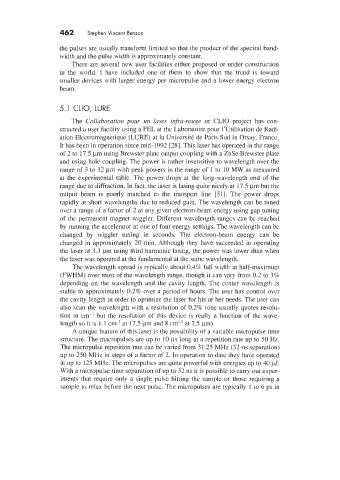Page 502 - Tunable Lasers Handbook
P. 502
462 Stephen Vincent Benson
the pulses are usually transform limited so that the product of the spectral band-
width and the pulse width is approximately constant.
There are several new user facilities either proposed or under construction
in the world. I have included one of them to show that the trend is toward
smaller devices with larger energy per micropulse and a lower energy electron
beam.
5.1 CLIO, LURE
The Collaboration pour un laser irfra-rouge or CLIO project has con-
structed a user facility using a FEL at the Laboratoire pour 1'Utilisation de Radi-
ation Electromagnetique (LURE) at la UniversitC de Paris Sud in Orsay, France.
It has been in operation since mid-1992 [28]. This laser has operated in the range
of 2 to 17.5 pm using Brewster plate output coupling with a ZnSe Brewster plate
and using hole coupling. The power is rather insensitive to wavelength over the
range of 3 to 12 ym with peak powers in the range of 1 to 10 MW as measured
at the experimental table. The pobver drops at the long-wavelength end of the
range due to diffraction. In fact, the laser is lasing quite nicely at 17.5 pm but the
output beam is poorly matched to the transport line [51]. The power drops
rapidly at short wavelengths due to reduced gain. The wavelength can be tuned
over a range of a factor of 2 at any given electron-beam energy using gap tuning
of the permanent magnet wiggler. Different wavelength ranges can be reached
by running the accelerator in one of four energy settings. The wavelength can be
changed by wiggler tuning in seconds. The electron-beam energy can be
changed in approximately 20 min. Although they have succeeded in operating
the laser at 3.3 pm using third harmonic lasing, the power was lower than when
the laser was operated at the fundamental at the same wavelength.
The wavelength spread is typically about 0.4% full ividth at half-maximum
(FWHM) over most of the wavelength range. though it can vary from 0.2 to 3%
depending on the wavelength and the cavity length. The center wavelength is
stable to approximately 0.2% over a period of hours. The user has control over
the cavity length in order to optimize the laser for his or her needs. The user can
also scan the wavelength with a resolution of 0.2% (one usually quotes resolu-
tion in cm-l but the resolution of this device is really a function of the wave-
length so it is 1.1 cm-' at 17.5 pm and 8 cm-' at 2.5 pm).
A unique feature of this laser is the possibility of a variable micropulse time
structure. The macropulses are up to 10 ps long at a repetition rate up to 50 Hz.
The micropulse repetition rate can be varied from 3 1.25 MHz (32-ns separation)
up to 250 MHz in steps of a factor of 2. In operation to date they have operated
at up to 125 MHz. The micropulses are quite powerful with energies up to 40 pJ.
With a micropulse time separation of up to 32 ns it is possible to carry out exper-
iments that require only a single pulse hitting the sample or those requiring a
sample to relax before the next pulse. The micropulses are typically 1 to 6 ps in

